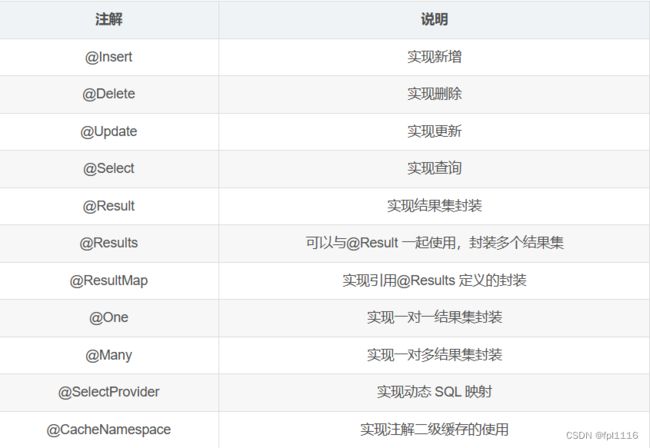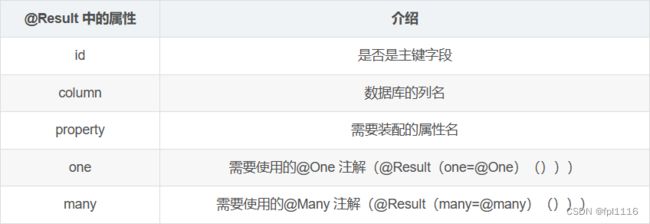mybatis注解开发简单使用
mybatis注解开发使用
mybatis的常用注解
使用注解方式开发持久层接口(不再需要编写mapper.xml文件)
/**
* 在mybatis中针对CRUD一共有四个注解
* @Select @Insert @Update @Delete
*/
public interface IUserDao {
/**
* 查询所有用户
* @return
*/
@Select("select * from user")
List<User> findAll();
/**
* 保存用户
* @param user
*/
@Insert("insert into user(username,address,sex,birthday)values(#{username},#{address},#{sex},#{birthday})")
void saveUser(User user);
/**
* 更新用户
* @param user
*/
@Update("update user set username=#{username},sex=#{sex},birthday=#{birthday},address=#{address} where id=#{id}")
void updateUser(User user);
/**
* 删除用户
* @param userId
*/
@Delete("delete from user where id=#{id}")
void deleteUser(Integer userId);
/**
* 根据id查询用户
* @param userId
* @return
*/
@Select("select * from user where id=#{id}")
User findById(Integer userId);
/**
* 根据用户名称模糊查询
* @param username
* @return
*/
//@Select("select * from user where username like #{username}") //占位符
@Select("select * from user where username like '%${value}%'") //字符串拼接
List<User> findByName(String username);
/**
* 查询总数量
* @return
*/
@Select("select count(*) from user")
int findTotal();
}
使用注解实现复杂关系映射开发
实现复杂关系映射之前我们可以在映射文件中通过配置 resultMap标签来实现,在使用注解开发时我们需要借助@Results 注解,@Result 注解,@One 注解,@Many 注解。
@Results 注解
代替的是标签resultMap
该注解中可以使用单个@Result 注解,也可以使用@Result 集合
@Results({@Result(),@Result()})或@Results(@Result())
@One 注解(一对一)
代替了assocation标签,是多表查询的关键,在注解中用来指定子查询返回单一对象。
@One 注解属性介绍:
select 指定用来多表查询的 sqlmapper
fetchType 会覆盖全局的配置参数 lazyLoadingEnabled。
使用格式:@Result(column=" “,property=”“,one=@One(select=”"))
public interface IAccountDao {
/**
* 查询所有账户,并且获取每个账户下的用户信息,一对一
* @return
*/
@Select("select * from account")
@Results(id="accountMap",value = {
@Result(id = true,column = "id",property = "id"),
@Result(column = "uid",property = "uid"),
@Result(column = "money",property = "money"),
@Result(property = "user",column = "uid",one=@One(select="com.keafmd.dao.IUserDao.findById",fetchType= FetchType.EAGER))
})
List<Account> findAll();
}
public interface IUserDao {
/**
* 查询所有用户
* @return
*/
@Select("select * from user")
@Results(id="userMap",value={
@Result(id = true,column = "id",property = "userId"),
@Result(column = "id",property = "userId"),
@Result(column = "username",property = "userName"),
@Result(column = "sex",property = "userSex"),
@Result(column = "birthday",property = "userBirthday")
})
List<User> findAll();
/**
* 根据id查询用户
* @param userId
* @return
*/
@Select("select * from user where id=#{id}")
//@ResultMap(value={"userMap"})
@ResultMap("userMap")
User findById(Integer userId);
/**
* 根据用户名称模糊查询
* @param username
* @return
*/
@Select("select * from user where username like #{username}") //占位符
@ResultMap("userMap")
List<User> findByName(String username);
}
@Many 注解(多对一)
代替了collection标签,是是多表查询的关键,在注解中用来指定子查询返回对象集合。
注意:聚集元素用来处理“一对多”的关系。需要指定映射的 Java 实体类的属性,属性的 javaType(一般为 ArrayList)但是注解中可以不定义。
使用格式:@Result(property=“”,column=“”,many=@Many(select=“”))
public interface IUserDao {
/**
* 查询所有用户
* @return
*/
@Select("select * from user")
@Results(id="userMap",value={
@Result(id = true,column = "id",property = "userId"),
@Result(column = "id",property = "userId"),
@Result(column = "username",property = "userName"),
@Result(column = "sex",property = "userSex"),
@Result(column = "birthday",property = "userBirthday"),
@Result(property = "accounts" ,column = "id",
many = @Many(select = "com.keafmd.dao.IAccountDao.findAccountByUid",
fetchType = FetchType.LAZY))
})
List<User> findAll();
/**
* 根据id查询用户
* @param userId
* @return
*/
@Select("select * from user where id=#{id}")
//@ResultMap(value={"userMap"})
@ResultMap("userMap")
User findById(Integer userId);
/**
* 根据用户名称模糊查询
* @param username
* @return
*/
@Select("select * from user where username like #{username}") //占位符
@ResultMap("userMap")
List<User> findByName(String username);
}
public interface IAccountDao {
/**
* 查询所有账户,并且获取每个账户下的用户信息,一对一 ,* 这里用不到这个findAll()
* @return
*/
@Select("select * from account")
@Results(id="accountMap",value = {
@Result(id = true,column = "id",property = "id"),
@Result(column = "uid",property = "uid"),
@Result(column = "money",property = "money"),
@Result(property = "user",column = "uid",one=@One(select="com.keafmd.dao.IUserDao.findById",fetchType= FetchType.EAGER))
})
List<Account> findAll();
/**
* 根据用户id查询账户信息
* @param userId
* @return
*/
@Select("select * from account where uid = #{userId}")
List<Account> findAccountByUid(Integer userId);
}

